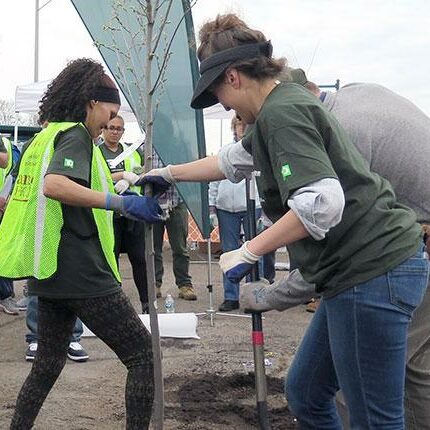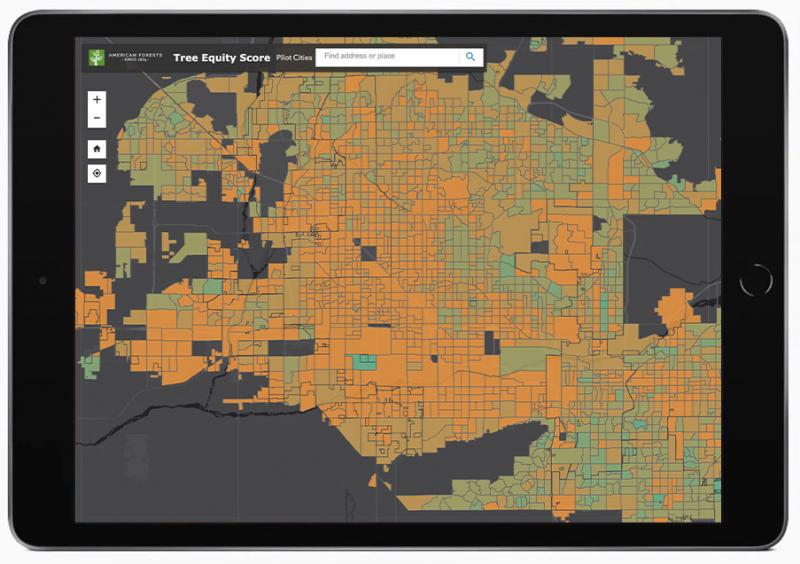
Published in 2020
Mission statement
Building on a 145-year history, American Forests’ mission is to create healthy and resilient forests from cities to wilderness that deliver essential benefits for climate, people, water and wildlife. American Forests advances this mission through forestry innovation, place-based partnerships to plant and restore forests and movement building.
The Urban Forests for Climate & Health pilot project in Rhode Island strategically optimizes urban forests’ ability to slow climate change in a way that protects public health and creates career opportunities.
Trees are more than scenery for cities. They are critical life-saving infrastructure that every person in every neighborhood deserves. As synthesized on Vibrant Cities Lab, living around trees and other vegetation can have profound impacts on individual and community well-being. Research has shown a healthy tree canopy can improve academic performance in children, enhance mental health, reduce crime, lower hospitalizations and much more. Not surprisingly, socioeconomically disadvantaged neighborhoods often have less tree canopy. This is mainly due to a legacy of disinvestment in communities of color and low-income neighborhoods, such as federal redlining. Addressing this disparity is what American Forests calls creating Tree Equity.
Core focus area
The Urban Forests for Climate & Health pilot project in Rhode Island is creating a suite of tools to help address this problem. The first collaboration between the Doris Duke Charitable Foundation’s Environment Program and its Child Well-being Program, the project is developing this suite of urban forest planning tools, policy initiatives and innovative financing mechanisms to equitably expand tree canopy and career opportunities in Rhode Island’s urbanized areas, including their designated Health Equity Zones. The project was kicked off by Governor Gina Raimondo at a Woonsocket tree planting in the spring of 2019 and includes a range of urban forestry and public health stakeholders. They include: Rhode Island Department of Health (RIDOH), Rhode Island Department of Environmental Management (RIDEM), Rhode Island Infrastructure Bank (RIIB), municipal urban foresters, local organizations like the Providence Neighborhood Planting Program, Groundwork Rhode Island and the Newport Tree Conservancy, as well as institutional partners such as Yale University and The Nature Conservancy.
Tree Equity Score

Every urbanized neighborhood (census block group) in Rhode Island will receive a Tree Equity Score — created using the first-ever standardized method to measure Tree Equity. The score is calculated from a synthesis of data points: employment, ethnicity, age dependency for elders and children, tree canopy, surface temperature, development density and tree canopy data relative to nearby wealthier neighborhoods. Each score is an indicator of whether a neighborhood has a sufficient number of trees so all people experience the health, economic and other benefits that trees provide. The scores identify where low tree canopy overlaps with socioeconomic and environmental needs and can be used by municipalities and nonprofits to focus limited resources in areas with the highest need. The goal is to improve every neighborhood’s Tree Equity Score.
Tree Equity Score Analyzer
Rhode Island partnered with American Forests to go beyond Tree Equity Score by creating the Tree Equity Score Analyzer (TESA). This free, state-of-the-art interactive tool supports both policy and project-level interventions by incorporating local data, such as hospitalizations, carbon sequestration and flood risk, with ownership parcels. TESA can help urban foresters, city managers and community advocates identify parcel-specific planting opportunities and estimate the impacts of tree planting scenarios. Users are also able to generate an impact report that quantifies such factors as carbon sequestration, stormwater infiltration and air pollution captured.
Climate & Health Action Guide
Developed in partnership with the Northern Institute of Applied Climate Science (NIACS) at the US Forest Service and social scientist Dr. Kathy Wolf, the Climate & Health Action Guide was recently published in a beta phase on Vibrant Cities Lab. This technical guide helps urban foresters and city managers plan, design and select an overarching strategy for their urban forestry programs to create the relationships and investments needed to slow climate change and improve public health. The guide also includes an interactive tree species list for Rhode Island to ensure the urban trees being grown in nurseries and planted today survive rising temperature projections and are optimized for public health benefits.
Innovative Financing
Making Tree Equity a reality in Rhode Island’s Health Equity Zones requires unprecedented investment in urban forestry. With the public sector, the project stakeholders are working at both the state and federal policy levels to integrate tree canopy into state bond measures and to pass bipartisan and multi-disciplinary federal legislation. For example, the TREE Act, which recently passed in the U.S. House of Representatives, would create a cost-share grant program at the Department of Energy to lower energy usage by allocating $50 million a year to plant at least 300,000 trees each year through 2025 in residential neighborhoods nationwide.
To spur private investment, this project is also helping to expand City Forest Credits. This new finance mechanism was adapted from the traditional voluntary carbon market model to increase investment in the health of urban forests and the people who live among them. These carbon+ credits calculate the dollar value of all of the co-benefits city trees provide, like rainfall interception, air quality improvements and energy savings. They also calculate the costs avoided by planting trees — such as higher bills for air conditioning if trees were not shading buildings. Companies can then buy carbon+ credits from local city projects in return for long-term tree maintenance funding.
To identify best practices from these and other efforts, the Rhode Island Infrastructure Bank is developing a funding and policy guide as part of this project.
Learning Lab
In early 2021, an interactive online learning lab will train urban foresters, city managers and advocates statewide in using the suite of tools and resources in their municipalities and neighborhoods.
Health Equity Zone Plantings
To kick off the implementation phase, a $100,000 tree planting project in one of the Rhode Island’s Health Equity Zones will demonstrate the value of the climate and health tools. This project will be among the first City Forest Credits carbon+ projects in Rhode Island.
State Tree Equity Goal
In collaboration with Governor Raimondo, a Tree Equity goal is being developed and is planned to be announced during the kickoff planting in Rhode Island. The goal will pioneer a new way of setting state, metropolitan and municipal tree canopy goals, potentially replacing “million tree” style planting campaigns that have often failed to reach their goals. This more comprehensive forestry approach will focus on creating jobs by strategically planting, maintaining and reusing trees where they have the greatest socioeconomic and public health impact. Establishing a Rhode Island Tree Equity goal will help track the impact of the planning, finance and policy tools.
Adjustments
The original project scope included a nationwide network of grassroots policy advocates. This proved to exceed the capacity of partners nationwide to effectively coordinate such a network. A more “grasstops” approach is currently being developed to harness city sustainability leaders, prominent local and national nonprofit partners and other champions for critical federal legislation in the 2021 session.
